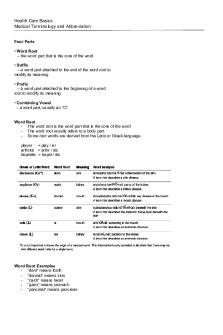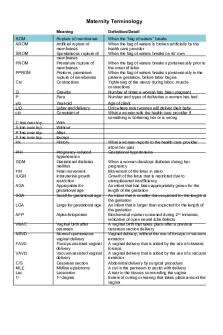Root words of medical terminology terms PDF

| Title | Root words of medical terminology terms |
|---|---|
| Course | Medical Terminology |
| Institution | Herzing University |
| Pages | 4 |
| File Size | 85.9 KB |
| File Type | |
| Total Downloads | 11 |
| Total Views | 221 |
Summary
root words for medical terminolgy, the meaning of words...
Description
Terminology in Healthcare and Public Health Settings, Understanding Medical Words Audio Transcript Slide 1 Welcome to Terminology in Healthcare and Public Health Settings, Understanding Medical Words. This is Lecture A, Word Roots. In this first lecture of Understanding Medical Words, we will cover some general concepts regarding medical terminology, but we will primarily focus on word roots and combining vowels. Slide 2 The Objectives for this unit, Understanding Medical Words, are to: •
Discuss the four parts of medical terms
•
Recognize word roots and combining forms
•
Identify the most common prefixes and suffixes
•
Describe the anatomical positions
•
Define the body planes
•
Identify regions of the body
•
Define directional and positional terms
•
Build, divide, spell and pronounce common medical words
Slide 3 Studying medical terminology is like learning a new language. There are basic rules for building terms that will help you both build and translate many different words that you will encounter throughout your healthcare career in Health IT. In order to be successful, you must be able to put words together or build words from their parts. It’s much like putting together the pieces of a puzzle. Slide 4 It is impossible to memorize all of the thousands of medical terms. If you are able to figure out the words and their meanings by analyzing their word parts, however, you will be able to understand much of medical terminology. There are four basic word parts that we will discuss. These include:
Health IT Workforce Curriculum Version 3.0 / Spring 2012
Terminology in Healthcare Understanding Medical Words Lecture a
1
This material (Comp3_Unit1a) was developed by the University of Alabama at Birmingham funded by the Department of Health and Human Services, Office of the National Coordinator for Health Information Technology under Award Number IU24OC000023.
Word roots Prefixes Suffixes Combining forms Slide 5 The word root provides the general meaning of the term and is the key part of the term. Prefixes are added to the beginning of the word, while suffixes are added to the ending of the word. Combining vowels allow us to connect different word parts together. Slide 6 Here’s an example of how each is used. The first word is cardiology. The word root is cardi (pronounced CARD-ee) which means heart. So our term cardiology means study of the heart. The second word example is tachycardia (pronounced tacky-CARD-ee-uh). The prefix is tachy (pronounced tacky), which means fast. So this term literally means fast heart. The third word example is carditis (pronounced car-dite-iss). The suffix itis (pronounced ite-iss) means inflammation. Carditis is inflammation of the heart. The fourth word is cardiomyopathy (pronounced CARDIO-my-OPP-uh-thy (like theology). We are combining cardi or heart, and my or muscle, with pathy or disease. We need to use combining vowels in order to connect each of these. We will be using the vowel “o”. The term cardiomyopathy is disease of the heart muscle. Slide 7 Word roots are the Core part of the term. They also provide the general meaning of the word. Word roots usually refers to a body part. Examples include Oste (pronounced oss-tee)-- bone Cardi -- heart Rhino (pronounced rhino like rhinocerous) -- nose Slide 8 Combining Vowels make it possible to pronounce long terms. Combining vowels combine two word parts such as between two word roots or between a word root and a suffix. The vowel that is usually used is an “o”. Slide 9 Health IT Workforce Curriculum Version 3.0 / Spring 2012
Terminology in Healthcare Understanding Medical Words Lecture a
2
This material (Comp3_Unit1a) was developed by the University of Alabama at Birmingham funded by the Department of Health and Human Services, Office of the National Coordinator for Health Information Technology under Award Number IU24OC000023.
Just like any language there are rules regarding the use of vowels. The rule we see in this slide deals with the use of the combining vowel between a word root and a suffix. If the suffix begins with a vowel, we do not use a combining vowel. For example, in the word arthritis, ‘arthr’ means joint and ‘itis’ (pronounced ite-iss) means inflammation. Typically, to combine the two we would use the combining vowel “o”...but because the suffix “itis” begins with a vowel, we would not use the “o”. We would just connect the two words together to form the word ‘arthritis.’ If the suffix begins with a consonant, we would use the combining vowel and we would typically use the combining vowel “o”. For example, in the word arthroscope, arthr means joint, scope means examine. Since the suffix begins with a consonant, we would add the combining vowel to connect the two parts together to come up with ‘arthroscope.’(pronounced ARTH-ro-scope) Slide 10 This next rule deals with using a combining vowel between two word roots. We typically will use the combining vowel between two root words even if the second word root begins with a vowel. The example used is gastroenteritis (pronounced gas-tro-enter-iteiss). The first root word, G-A-S-T-R means stomach, the second root word is enter, which means pertaining to the intestine. The last part of the word is itis, which mean inflammation.. Slide 11 When we typically write word roots, we will include the combining vowel. The format that is used is the word root followed by a slash and then the combining vowel. Three examples are provided to illustrate this....cardio (pronounced CARD-ee-oh).....hepato (pronounced heh-PAT-oh ).....gastro (pronounced gastro) Slide 12 Examples of word roots and their combining vowel are illustrated here: arthro - joint cardio - heart dermato (pronounced Der-MAT-oh) - skin entero (pronounced EN-tero) - small intestine gastro - stomach hemato (pronounced hee-mat-oh) - blood nephro - kidney Health IT Workforce Curriculum Version 3.0 / Spring 2012
Terminology in Healthcare Understanding Medical Words Lecture a
3
This material (Comp3_Unit1a) was developed by the University of Alabama at Birmingham funded by the Department of Health and Human Services, Office of the National Coordinator for Health Information Technology under Award Number IU24OC000023.
neuro - nerve oto (pronounced oh-toe) - ear pulmono (pronounced PULL-muh-no)- lung rhino - nose uro (pronounced You-ro) - urine, urinary system Slide 13 This concludes Lecture a of Understanding Medical Words. In summary, we covered some general concepts regarding medical terminology, focusing primarily on word roots and combining vowels. Slide 14 No audio end
Health IT Workforce Curriculum Version 3.0 / Spring 2012
Terminology in Healthcare Understanding Medical Words Lecture a
4
This material (Comp3_Unit1a) was developed by the University of Alabama at Birmingham funded by the Department of Health and Human Services, Office of the National Coordinator for Health Information Technology under Award Number IU24OC000023....
Similar Free PDFs

Medical Terminology Terms
- 22 Pages

Medical Terminology - terms
- 9 Pages

Medical Terminology
- 50 Pages

Medical Terminology
- 6 Pages
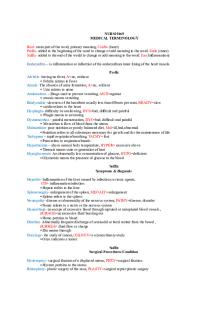
Medical Terminology
- 2 Pages

Medical Terminology
- 4 Pages
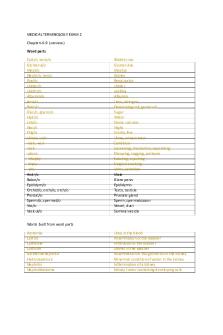
Medical Terminology EXAM 2
- 4 Pages

Medical terminology Modules
- 158 Pages
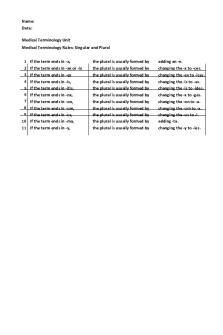
Medical Terminology-Plurals Quiz
- 3 Pages

Medical terminology 17
- 4 Pages
Popular Institutions
- Tinajero National High School - Annex
- Politeknik Caltex Riau
- Yokohama City University
- SGT University
- University of Al-Qadisiyah
- Divine Word College of Vigan
- Techniek College Rotterdam
- Universidade de Santiago
- Universiti Teknologi MARA Cawangan Johor Kampus Pasir Gudang
- Poltekkes Kemenkes Yogyakarta
- Baguio City National High School
- Colegio san marcos
- preparatoria uno
- Centro de Bachillerato Tecnológico Industrial y de Servicios No. 107
- Dalian Maritime University
- Quang Trung Secondary School
- Colegio Tecnológico en Informática
- Corporación Regional de Educación Superior
- Grupo CEDVA
- Dar Al Uloom University
- Centro de Estudios Preuniversitarios de la Universidad Nacional de Ingeniería
- 上智大学
- Aakash International School, Nuna Majara
- San Felipe Neri Catholic School
- Kang Chiao International School - New Taipei City
- Misamis Occidental National High School
- Institución Educativa Escuela Normal Juan Ladrilleros
- Kolehiyo ng Pantukan
- Batanes State College
- Instituto Continental
- Sekolah Menengah Kejuruan Kesehatan Kaltara (Tarakan)
- Colegio de La Inmaculada Concepcion - Cebu



